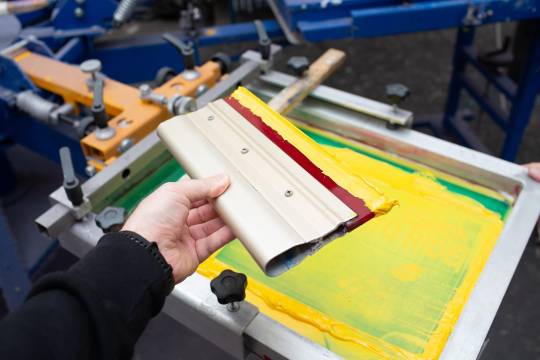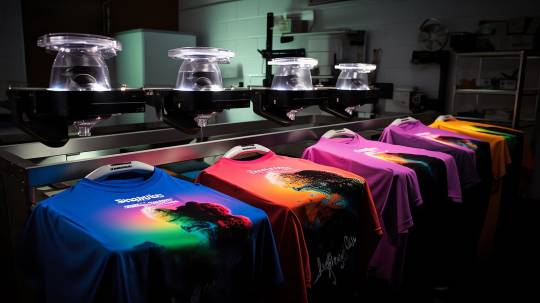Don't wanna be here? Send us removal request.
Text
DTG vs. Screen Printing: What Every Print Shop Should Know Before Choosing
If you run a print shop or supply one, chances are you’ve already heard the debate: Direct-to-Garment (DTG) printing or traditional screen printing — which is better? The short answer is: it depends. The long answer? That’s what this post is for.
As a supplier who works directly with screen printers, apparel decorators, and fulfillment shops across the U.S., we’ve seen firsthand how the decision to go DTG or stick with screen printing can shape your production efficiency, customer satisfaction, and long-term profit.
This article is designed to help you — or the shops you serve — understand when each method makes sense. Whether you’re outfitting an established screen printer or consulting with a newer shop considering digital, this comparison gives you the facts.
What Is DTG Printing?
Direct-to-Garment (DTG) is a digital print process where a specially formulated ink is sprayed directly onto the fabric. The printer works similarly to an inkjet desktop printer, using CMYK and white inks. It requires minimal manual labor and no screen setup, which makes it a go-to solution for short runs, personalized designs, and online fulfillment models.
For a print shop, DTG is attractive because of its flexibility. You can run a dozen different one-off prints without reconfiguring your setup. Personalization, print-on-demand, and photographic images are where DTG shines.

What Is Screen Printing?
Screen printing remains the backbone of the commercial apparel printing industry for a reason. It’s a time-tested, durable process that excels in cost-efficiency and speed when printing large quantities of the same design.
The setup requires more steps: burning screens, mixing inks, registering colors — but once a job is set up, it flies. A well-trained press operator on a manual press can produce 100+ garments an hour. On an automatic, that number jumps significantly.
Screen printing also gives you more control over ink types and special effects. Need puff ink, metallics, neon, glow-in-the-dark, or discharge printing? Screen printing is the only option. And with access to premium supplies like Wilflex Epic, Union Ink, and water-based options from Rutland or Virus Inks, you can match nearly any creative request.
As a supplier, we recommend screen printing for shops that regularly fulfill bulk orders, prioritize ink durability, and want consistent prints across large runs.
Key Differences Every Shop Should Understand
The most important distinction is volume.
DTG is great for small batches — especially under 24 units — where variety is high and repetition is low. It’s ideal for custom jobs, e-commerce fulfillment, or samples. But as soon as you cross into 50–100+ units of the same design, screen printing becomes significantly more efficient per shirt.
Color complexity is another factor. DTG doesn’t charge you more for 10 colors versus one. It’s all printed digitally. That’s great for full-color graphics, gradients, and photo-level detail. In screen printing, every color means an additional screen, more setup, and higher cost. But screen printing offers better opacity on dark garments, richer finishes, and broader ink compatibility across fabrics.

Questions Print Shops Are Asking (and You Should Be Too)
How many shirts before screen printing becomes more cost-effective than DTG? Typically, anything above 50–70 units is where screen printing wins on per-unit cost. Below that, DTG’s zero setup makes it more efficient.
Can I run both methods in one shop? Absolutely. Many shops use DTG for online store fulfillment and screen printing for large client orders. This hybrid model is common in growing operations.
Can DTG print on polyester or performance fabrics? Not reliably. DTG works best on 100% cotton. Printing on synthetics or tri-blends often leads to poor wash durability unless you’re using specialized pretreatment. Screen printing handles synthetics with the right inks and additives.
Is screen printing still profitable in a digital-first market? Very much so. Despite the rise of DTG, screen printing remains the most scalable, cost-efficient, and high-margin print method in the industry — especially when paired with the right inks and mesh counts.
What kind of ink support do I need for either method? For screen printing, your success depends on ink quality, mesh selection, squeegee pressure, and curing temperature. That’s where working with a supplier like us makes the difference. We provide not just inks but expert recommendations on which formulas are best for soft-hand prints, stretch fabrics, or low-bleed substrates.
Why This Comparison Matters for the Shops You Serve
If you’re supplying to print shops, your role goes beyond just moving boxes of ink and emulsion. You’re offering strategic input that helps them stay competitive, reduce returns, and boost production. Helping your clients understand when to use DTG versus screen printing strengthens your credibility and builds long-term loyalty.
That’s why we encourage you to carry and recommend supplies that support both technologies. Pretreatment fluids, platen adhesives, and DTG-friendly blanks are just as valuable as high-opacity plastisol, water-based inks, reclaim chemicals, and exposure units.
And when you need support or fast restocks, we’ve got you covered. Whether it’s mesh screens, squeegees, scoop coaters, emulsions, or cleaning solutions, we keep your shop — and your clients’ shops — running on time and printing clean.
Final Word: Both Methods Have Their Place. It’s About Matching the Right Job to the Right Tool.
DTG and screen printing don’t compete — they complement each other. Your job as a supplier or shop owner is to understand when and how to use each one for maximum output and client satisfaction.
If you’re printing 12 shirts with full-color art for a last-minute event, DTG is the answer. If you’re fulfilling 300 shirts for a brewery launch, screen printing will save you time, money, and effort.
Need help choosing the right setup or sourcing the best inks for your print shop clients? We’re here to support that decision with proven products and industry-tested guidance.
Explore more at BucketsofInk
Let’s keep your shop — and your customers’ shops — printing profitably, efficiently, and boldly.
0 notes
Text
How do I choose a good DTF ink?
1 note
·
View note